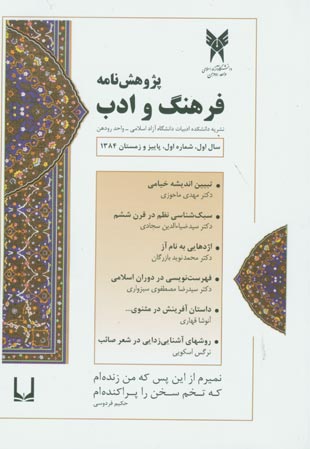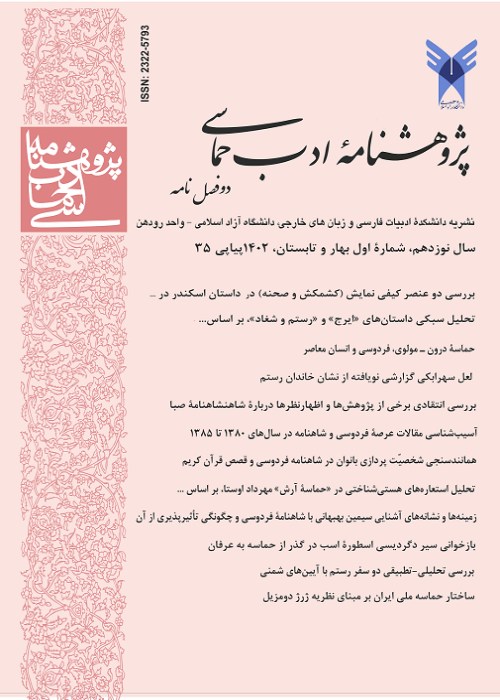فهرست مطالب

پژوهشنامه ادب حماسی
پیاپی 1 (پاییز و زمستان 1384)
- 208 صفحه،
- تاریخ انتشار: 1384/12/20
- تعداد عناوین: 8
-
صفحه 11
-
صفحه 15
شاید هیچ گوینده و متفکری چون حکیم عمر خیام نیشابوری، مورد توجه و اقبال جهانیان نبوده است و هیچ اثری چون رباعیات وی موضوع گفتگوها، بحث ها،پژوهش ها، ترجمه ها و نقدهای جهان شرق و غرب قرار نگرفته است. اعتقاد بنده این است که تبیین اندیشه خیامی جز از اخلال رباعی ها مقبول الاصاله وی میسر نیست و آن چه اصالت هر رباعی را تایید می کند، سازگاری و توازن مفاهیم آن است...
کلیدواژگان: رباعی های اصیل، رباعی های دخیل، منظومه فکری خیام، بدایت و نهایت جهان، شک فلسفی، ترکیب و انحلال، اتقان صنع، قناعت و خرسندی، حصار تعصب -
صفحه 55
در این مقاله از مختصات سبک شناسی نظم در قرن ششم سخن رفته است. مبدا بحث در این زمینه بررسی مختصات سبک شناختی در آثار سنائی غزنوی است که موجب تحولی اساسی در شعر فارسی گردید و پایان این تحول در قرن ششم، سال تصنیف اقبال نامه نظامی و ختم اسکندرنامه اوست. شعر فارسی در این قرن از لحاظ موضوع، وزن، قالب، ترکیب الفاظ و قوافی، نوجویی و تازگی متحول...
کلیدواژگان: سبک شناسی نظم، گسترش موضوعات شعری قرن های 4 و5 در قرن ششم، بررسی عوامل تحول، ورود افکار صوفیانه و عارفانه، طنز، هجو، مرثیه، مدح، قصیده و غزل -
صفحه 101
ضحاک همواره اسطوره ای شگفت در میان شخصیت های اساطیری در ادبیات پیش از اسلام بوده است، آیا می توان دوره مشخص تاریخی برای او جست و یا آنچنان که اوستا تصویر می کند او همچنان شخصیتی نیمه اهریمنی، نیمه انسانی است که هویت واقعی اش در غبار زمانهای دور دست ناپیداست? این مقاله سعی دارد پرتوی بر تندیس این اسطوره کهن بیفکند و از خلال یک مقایسه...
کلیدواژگان: آز، ضحاک، آژی دهاک، اژدها، دیوبندی، دیو، زروان، خرد، آتش -
صفحه 137
اهمیت کتاب در طول تاریخ بشر کتمان ناپذیر است. نخستین خط شناخته شده در ایران باستان را دین دبیره- خطی که اوستا بدان نگارش یافته است دانسته اند. در نخستین متن های پارسی دری شواهدی موجود است که موازین خاصی را برای کتاب و کتابت تایید می دارد. برخی از اسناد تاریخی نیز نشان می دهد که کتابخانه های گرانبها و بزرگی در قرون اولیه پس از اسلام در ایران وجود داشته است که...
کلیدواژگان: کتابخانه، فهرست نویسی، فهرست نامه، نسخه های خطی -
صفحه 153
آفرینش الهی دلیل حضور ما در جهان است. اما آیا براستی می دانیم از کجا آمده ایم? و زبهر چه آمده ایم? یا انجام کار چیست? دغدغه این چرایی ها در ذهن و زبان بسیاری موج می زند و پاسخ آنان حکایت از تلاشی است که برای تخفیف دلنگرانی های بشری داشته اند. عرفان ایرانی اسلامی در مواجهه با این سوال مهم از منظر ویژه ای آن را مورد بررسی قرار داده است. آفرینش و داستان آدم و...
کلیدواژگان: مولانا، آفرینش، آدم، هبوط، عروج -
صفحه 175
یکی از نظریه های نقد ادبی معاصر، آشنایی زدایی defamiliariation می باشد و این روش به هر گونه تلاش هنری که رنگ رخوت و عادت را از هر دو سو تعامل ادبی می زداید و ادراک حسی و بازی با ذهن و هنر را بارور می کند، اطلاق می شود. صائب به عنوان نماینده سبکی که به تازه گویی و طرز نو و ابتکار شهرت دارد، یکی از نامبرداران تاریخ ادبیات فارسی در جهت آشنایی زدایی است. روش های...
کلیدواژگان: آشنایی زدایی، ساختار شکنی، ترکیبات مجازی، خلاف آمد عادت
-
Page 15
There is no thinker like Omar Khayyam Neishaboury. Likewise, there is no poetry which invites us as much to dialogue, discussion, and translation as his Quatrains. I would belive that the study of Khayyam's notion should be based on the corpus of his authentic Quatrains. In order to distinguish the Quatrains that were written by khayyam from the derivative ones, it is necessary to separate all of them by studying all this writings and comparing those Quatrains with the authentic ideas snd believes of khayyam which we withdrew from our study on all his works. In this paper constraints are introduced for identifying khayyam's authentic Quatrains. with the aid of these parameters, Quatrains which play a key-role in khayyam's thought were selected. On the basis of these results, it was possible to re-evaluate the understanding of khayyam's thought in European and Western Studies on this subject, from his own lifetime until the present day.
Keywords: Authentic Quatrains, Derivative Quetrains, khayyam's notion Commencement, Extremity of the universe, philosophic Skepticism, Combination, Dissolution, Stability of Creation, Continency, pleasure, The Block of Bigotry, The Fear of Death, Love for Living, Fate -
Page 55
Hereby we talk about the characteristics of verse stylistics in the th century. It's started with examinig Sanaii Ghaznavi's Poetry that was known as a Nezami's Eghbalnameh Coincided with the finishing of his EskandarNameh in the th century. In this century Persian poetry changed in many ways such as theme, rhythm, form, word, and rhyme blending, novelty and the khorasani's poetry styles developed in the th century, and the most significant change is the entrance of Sufi and mystical ideas which was started by sanaii and Nezami ended it. Manners like virtues, Lampoonic, and Satirizing Poems, Wise sayings, Panegyric verse, Death Elegies, etc. engaged the Poets thoughts in this century.
Keywords: Verse Stylistics, Examining Revolution Causes, progression of poetry subjects of the th, th century, Entrance of Sufi, Mystical I deas, Lampoonic, Stirizing, Panegyric Verse, Death Elegies, Ode, Lyric -
Page 101
Azidahak (zahhak) has always been a strange myth among the other mythological characters in pre-Islamic Literature. Is it possible to figure out a specific historical period for his life? Or as Avesta's image shows, we should consider him as a semi-human, semi-monster notion with three ugly heads on his shoulder? This article tries to put this figure on the spotlight and illuminate his real face through a rigorous comparison between Domon of AZ and Azidahak. The research basically aimed to obvious similarities between them and shows that azidahak is a very suitable body which AZ (greed) can hide in it. Some of pre Islamix texts in pahlavi language, introduce some different kinds of Daeva (monsters) who can hide in human body and control his/her behaviors. In other words Zahhak (as Shahnameh and pre Islamic tales has revealed) is a very interesting symbol of AZ. This mythological king is a symbol of whom greed has occupied their soul and manipulate them for his own purposes.
Keywords: AZ (Greed), Zahhak, Azidahak, Dragon, Demon Hartel, Demon, Zorvan, Wisdom, Fire -
Page 137
The importance and effectivness of book has been obvious for everyone during the history. Din Dabireh has been recognized as the primary book inscription in ancient Iran which was also the language of Avesta. In the First Dari Farsi texts some evidence were Found proving that there were some certain rules for the book and book inscription. Some of historical documents reveal that there had been many large and precious libraries in Iran in the First centuries after Islam, such as saheb Ebn Ebad's library, Jahez's library, Elmol Hoda's library, Rashid Vatvat's library, Noah Ebn Mansour's library and also the library of military school in Neishabour, and Baghdad. Therefore, index writing is also as important as book and book writing. We can name Alfehrest or Fehrestoloom by Ebn olNadim Baghdadi as an example Which has been Known in Europ Since Century. Index, writing in the Field of Persian Literature and culture went farther than Iran dominion. In this case we can name many of index writing in the India continent which has been provided for persian, Arabic, and Urdu books. In this essay we are going to indicate much of
Keywords: Library, Index, Hand Writing Transcription -
Page 153
The care of God for human beings and all that he has created are the reason of our existence in the world, But, indeed do we know how we are created? What is the purpose of our existence? Or what will be the end? The fear of these questions swells in the people's mind and say and their answers are the story of their efforts to mitigate the mankind's discouraging pains. Iranian Islamic Gnosticism has faced this important question and has evaluated it from a special aspect. The story of Adam and Eve's creation have been considered in the literary works of many well-known Gnostics, like Hallaj, Ebn-Arabi, Nasafi, Ataar, Molaana, Sanaii, etc. From the early to the next centuries of Islamic civilization. This article is attentive to details of the Gnostic's prominent ideas concerning the questions about the providential creation, the story of Adam and Eve's creation, the nature of satan, and Molaana's ideas on the subject of mankind creation and satan, are of the points which are treated in this article
Keywords: Molaana, Creation, Adam (peace be upon him), Descending, Ascending -
Page 175
Defamiliarization is one of the prominent theories of literary criticism. Every artistic efforts that helps to rub off habitude and listlessness between the addresse and the writer which develops sensational understanding, mind challenging and creativity, is defined as defamiliarization. It was introduced by V.B. Sheklovsky the Russian writer of past century, and now it is diverted in different types such as Lexical and syntactic. Saeb is one of the well-known poets of persian literature in the field of defamiliarization whom his creativity, new saying, and innovation was salient. In this essay we are going to examine the major Styles of Saeb Considering defamiliarization of word, speech, meaning, and the necessity of their usage.
Keywords: Defamiliarization, deconstruction, Figurative Combinations, Deviation of normality


